September 2005: The IRA needed somebody who could handle the poisoned chalice of decommissioning; a leader of such standing to be able to carry the conscience and the orders of its ‘army council’ into this next critical phase of the process. They chose one of the ‘hawks’ of the war - the Belfast republican Brian Keenan; a man the Canadian General John de Chastelain only ever referred to as ‘O’Neill’. Not once did I hear him call him by his name. It was part of the confidentiality of decommissioning - part of not telling its detail, and the IRA, at all times, was pushing back unionist demands for a published inventory and photographic proof. None of this happened. Nor was the DUP’s preferred witness present in that period of decommissioning that stretched from one weekend into another - between Saturday September 17th and Sunday September 25th 2005.
Brian Keenan was there throughout along with other members of the IRA; with the General and his colleagues and two Church witnesses - Fr Alec Reid and the former Methodist President Harold Good. All of them there in the places where the guns, the ammunition and the Semtex explosives were put beyond use. It was something that happened not that many days after the convulsion and the violence that was the fallout from the Whiterock Parade. The IRA could easily have used the events of that day to delay their decision, but chose not to.
On Sunday September 25th, I reported the presence of Harold Good as a church witness alongside Fr Reid. I was given Good’s name by a source within the DUP. And Aaro Suonio of the Independent International Commission for Decommissioning (IICD) advised me of a news conference scheduled for 2pm the next day - Monday September 26th 2005. General de Chastelain and the witnesses would add detail to this decommissioning story.
Before then, I spoke on the phone with Gerry Adams and, separately, with the IRA ‘P O’Neill’ - its leadership spokesman. This is some of what I noted in that conversation with the Sinn Féin President:
- The job’s done. It can’t be done twice;
- He expected de Chastelain to say that what was put beyond use matched the “estimates” - meaning the security force estimates of the IRA arsenal;
- The IRA will say no more than its done;
- We are all waiting to see how de Chastelain performs, and the church witnesses...Our worry is, and it’s a considerable worry, we engineered this initiative. We have no control of it.
In that final thought, he was thinking back to 2003 and to the last act of decommissioning, when the IRA put arms beyond use as part of a sequence to restore the political institutions at Stormont. But that initiative fell apart when the Ulster Unionist leader David Trimble demanded more detail from de Chastelain on what exactly had been destroyed; detail the Commission could not supply because of the confidentiality clauses of this process.
The call from the IRA, at 12.50 on September 26th 2005, was exactly what Adams suggested it would be. Two sentences were read to me:
“The leadership of Óglaigh na hÉireann announced on July 28th that we had authorised our representative to engage with the IICD to complete the process to verifiably put arms beyond use. The IRA leadership can now confirm that the process of putting our arms beyond use has been completed.” P O’Neill
This information was embargoed to 3pm, until after the Commission and the witnesses had spoken.
Paragraph 3 of the Commission’s report was as Adams had predicted; that matching of the security force estimates with the total weapons that had been put beyond use.
But is there such a thing as ‘total’ decommissioning? That statement was later challenged by intelligence reports that weapons had been held back: “that some individuals and groups within the IRA have retained a range of arms, including handguns”. The DUP leader Ian Paisley had spoken of “a complete failure from General John de Chastelain to deal with the vital numerics of decommissioning.”
“We do not know how many guns, ammunition and explosives were decommissioned, nor do we know how the decommissioning was carried out.”
The IRA did not add to the detail. Yet, in 2007, Ian Paisley entered government with Martin McGuinness, and de Chastelain’s attention turned to the weapons held by the loyalist organisation.
 The Preacher and the Prayer: This is history in a frame. In 2005, the former Methodist President Harold Good was a church witness to IRA decommissioning. They gave him this boiler suit to wear in the fields of rural Ireland, and he gave them a prayer - the timeless words of St Francis of Assisi. Image - Marie Therese Hurson
The Preacher and the Prayer: This is history in a frame. In 2005, the former Methodist President Harold Good was a church witness to IRA decommissioning. They gave him this boiler suit to wear in the fields of rural Ireland, and he gave them a prayer - the timeless words of St Francis of Assisi. Image - Marie Therese Hurson
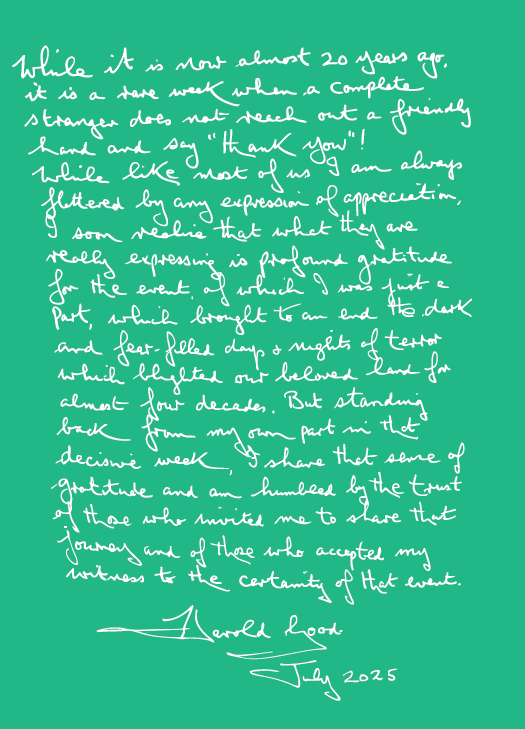 Harold Good - July 2025
Harold Good - July 2025
Text transcript
While it is now almost 20 years ago, it is a rare week when a complete stranger does not reach out a friendly hand and say "thank you"!
While like most of us I am always flattered by any expression of appreciation, I soon realise that what they are really expressing is profound gratitude for the event of which I was just a part, which brough to an end the dark and fear-filled days & nights of terror which blighted our beloved land for almost four decades. But standing back from my own part in that decisive week, I share that sense of gratitude and am humbled by the trust of those who invited me to share that journey and of those who accepted my witness to the certainty of that event.
Harold Good
July 2025
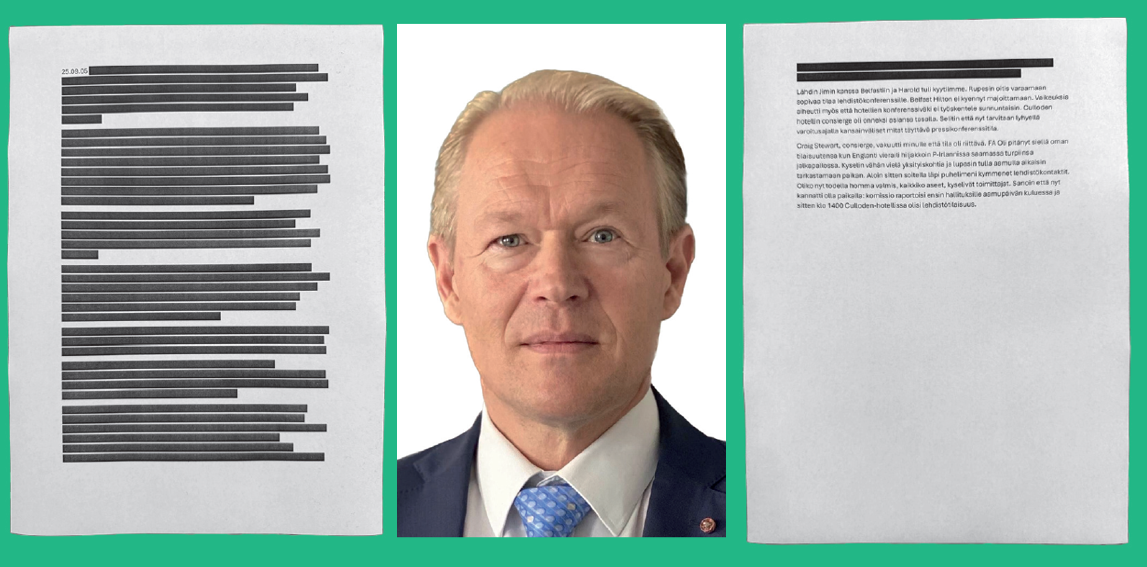 September 25th 2005: A diary entry that says everything about the secrecy and confidentiality of decommissioning - redacted and written in Finnish by Aaro Suonio of the IICD. The IRA has put its arms beyond use and Suonio is planning a news conference for the 26th involving the Commission and the church witnesses.
September 25th 2005: A diary entry that says everything about the secrecy and confidentiality of decommissioning - redacted and written in Finnish by Aaro Suonio of the IICD. The IRA has put its arms beyond use and Suonio is planning a news conference for the 26th involving the Commission and the church witnesses.
 Handwritten note from Aaro Suonio.
Handwritten note from Aaro Suonio.
Text transcript
(Editor's note: original punctuation preserved)
Helsinki 7 July 2025
The day the IRA's decomissioning was confirmed brought a quiet but profound sense of relief. It had been a long and difficult journey and now, finally, the weapons were verifiably gone. Still, even amidst that relief I could not shake a lingering concern: how would we convince the sceptics - particularly in the Unionist camp - that this was real? No photos, just trust and testimony. That very evening my focus was on arranging the international press conference at short notice, ensuring the message would reach the world. But my thoughts also turned to the Loyalist groups They hadn't believed this day would come. Now the burden of reciprocation was theirs...
(Signature)
Aaro Suonio
Former Chef de Cabinet
I.I.C.D
2006: Vacuums and Vocabulary
For all the headlines and history of what had just happened, politics and government as shaped in the Good Friday Agreement of 1998 were not functioning. We were experiencing one of the many vacuums in this process - with politics lost in some 'no man's land'. And while the Finnish official Aaro Suonio of the Independent International Commission on Decommissioning (IICD) correctly described the burden of reciprocation now being with the loyalist organisations, they were in no hurry to respond to what the IRA had done in terms of ending its armed campaign and putting its weapons beyond use.
"Quite frankly decommissioning is not a word that we use in our vocabulary." These words were spoken in April 2006 as part of an interview authorised by the leaderships of the UVF and Red Hand Commando. In a small room, on the Shankill Road in Belfast, I was sitting across the table from a man whose face was hidden behind a balaclava. The UVF flag had been positioned as a backdrop.
Months earlier, I had left the BBC weighed down by the heavy responsibility of reporting a long transition from conflict to peace; yet, here I was in another of those settings discussing vacuums and vocabulary and war and peace. My interview was broadcast by Ulster Television and carried on the pages of the Belfast Telegraph. It had been several decades since such an interview had taken place.
The loyalist concern expressed in April 2006 and, again, months later in August of that year, was not about the IRA, but about the very future of Northern Ireland. What if a Stormont deal between Paisley and McGuinness proved impossible? In such circumstances, would the British and Irish Governments impose a settlement in the form of joint authority and in a deal that would establish London-Dublin rule? This was the loyalist fear of politics at this time - a concern about a so-called Plan B. So, the UVF and Red Hand Commando stalled until the Spring of 2007 until they had the answers to those questions, and waited longer still before disarmament became a serious part of their vocabulary and conversations.
 April 2006 - Rowan interview with UVF leadership. From behind the mask , decommissioning is dismissed as not a word we use in our vocabulary. In 2009, their contacts with the IICD would lead to arms being put beyond use.
April 2006 - Rowan interview with UVF leadership. From behind the mask , decommissioning is dismissed as not a word we use in our vocabulary. In 2009, their contacts with the IICD would lead to arms being put beyond use.
Text transcript
NEWS SPECIAL: INTERVIEW WITH THE UVF
In what is understood to be its first official in-depth interview since the early 1970s, the leadership of the UVF talks to BRIAN ROWAN about its terrorist past ... and plans for the future
Brian Rowan talks to a hooded man "on the full authority of the brigade command" of the UVF
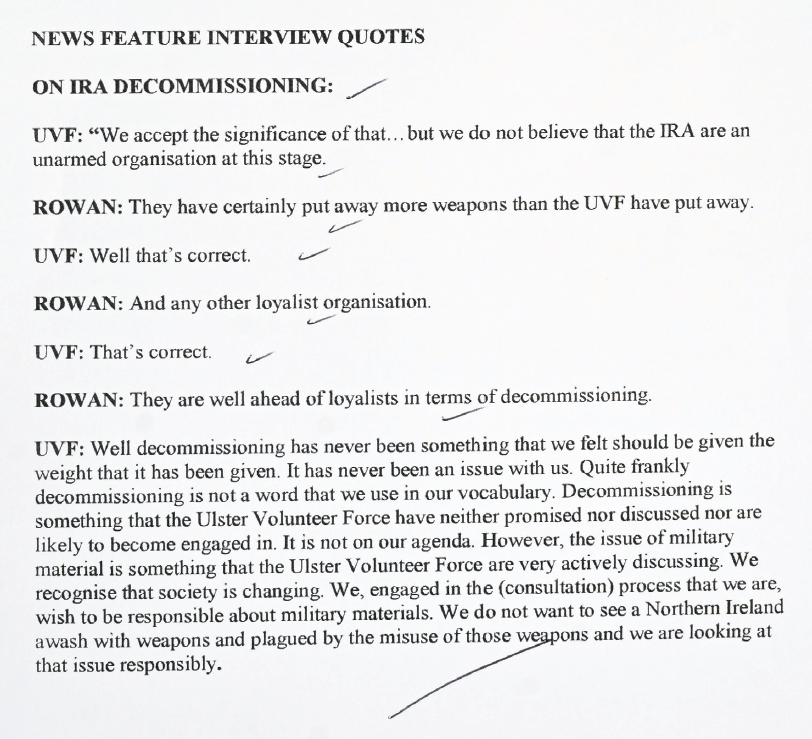 A part transcript of Rowan’s interview with the UVF April 2006 - included in his news copy to the Belfast Telegraph.
A part transcript of Rowan’s interview with the UVF April 2006 - included in his news copy to the Belfast Telegraph.
Text transcript
NEWS FEATURE INTERVIEW QUOTES
ON IRA DECOMMISSIONING:
UVF: "We accept the significance of that... but we do not believe that the IRA are an unarmed organisation at this stage.
ROWAN: They have certainly put away more weapons than the UVF have put away.
UVF: Well that's correct.
ROWAN: And any other loyalist organisation.
UVF: That's correct.
ROWAN: They are well ahead of loyalists in terms of decommissioning.
UVF: Well decommissioning has never been something that we felt should be given the weight that it has been given. It has never been an issue with us. Quite frankly decommissioning is not a word that we use in our vocabulary. Decommissioning is something that the Ulster Volunteer Force have neither promised nor discussed nor are likely to become engaged in. It is not on our agenda. However, the issue of military material is something that the Ulster Volunteer Force are very actively discussing. We recognise that society is changing. We, engaged in the (consultation) process that we are, wish to be responsible about military materials. We do not want to see a Northern Ireland awash with weapons and plagued by the misuse of those weapons and we are looking at that issue responsibly.
Download the archive (PDF, 37MB)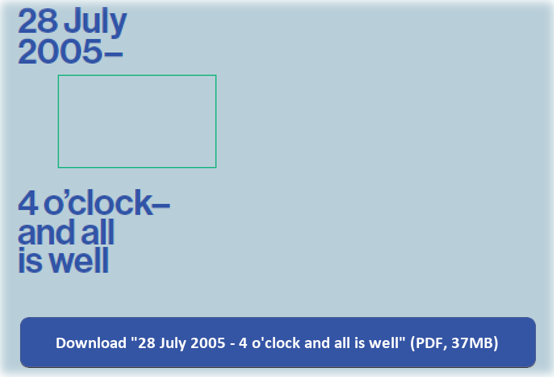

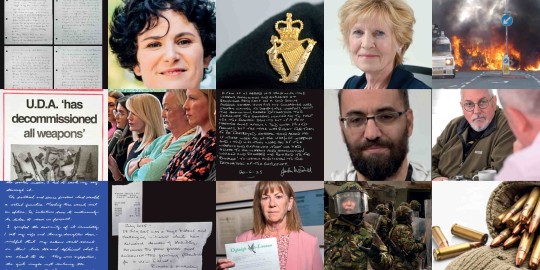
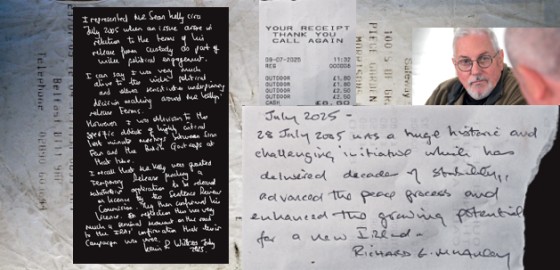
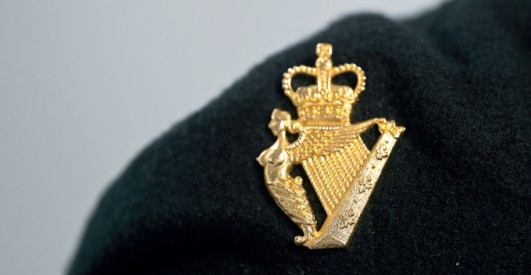
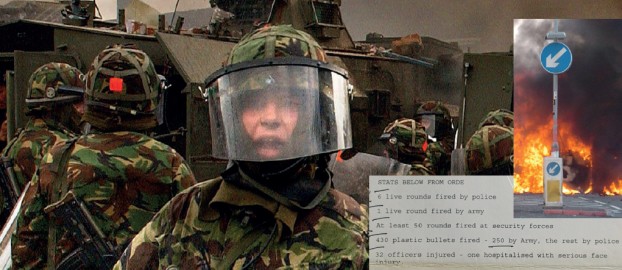

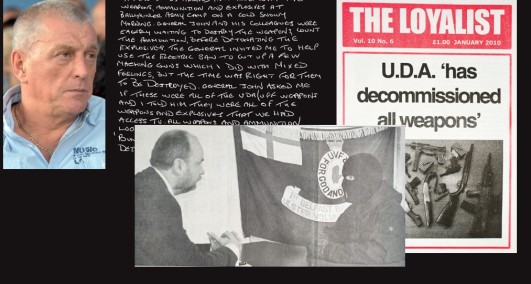
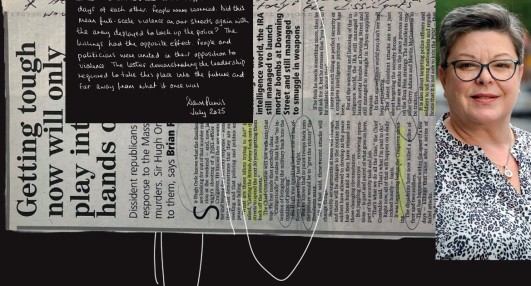
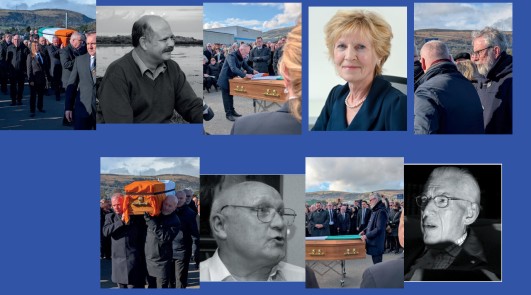


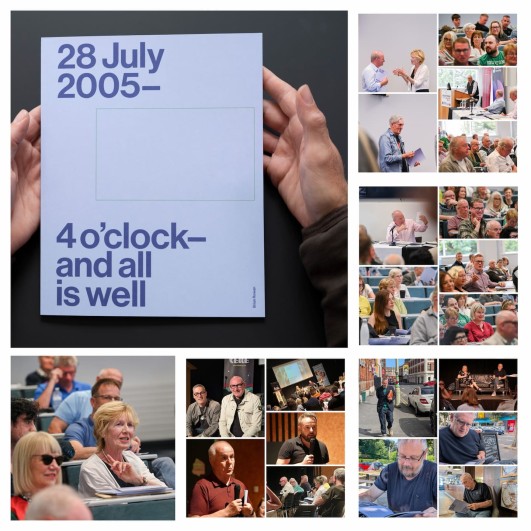

Rate and Review
Rate this article
Review this article
Log into OpenLearn to leave reviews and join in the conversation.
Article reviews